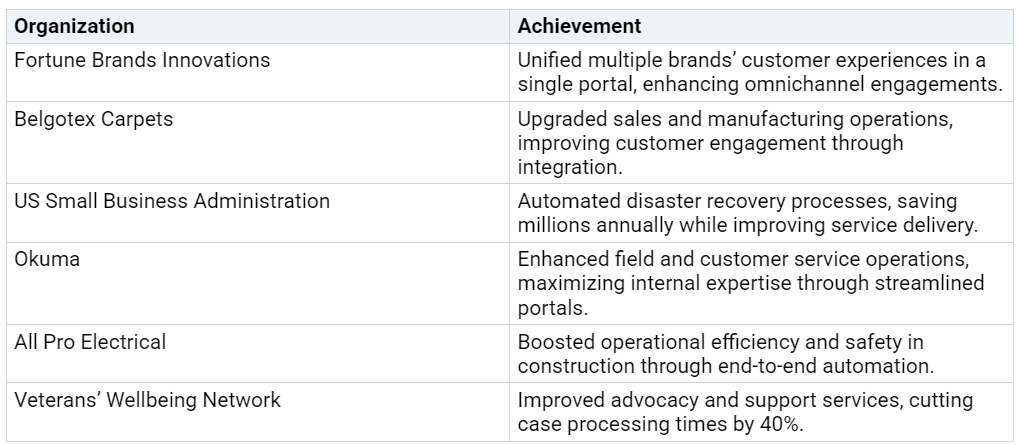Imagine transforming your business challenges into innovative solutions without relying on complex coding skills. Citizen developers are making this possible every day. By using tools like the Power Platform, you can empower your team to create apps, automate workflows, and analyze data faster than ever. This approach not only accelerates problem-solving but also helps your business stay ahead in a competitive market. The future belongs to those who embrace these game-changing opportunities
.
Key Takeaways
Citizen developers can make apps and automate tasks without coding. This helps everyone in your company use technology easily.
Supporting citizen developers saves time and money. Studies show businesses save 1.6 hours each week using these tools.
Microsoft Power Platform helps IT and business teams work together. It speeds up new ideas and reduces IT delays.
Training and giving tools to citizen developers improve work and encourage new ideas all the time.
Tracking progress with key measurements shows how helpful citizen development is. It also motivates people to keep joining in.
What Are Citizen Developers and Why They Matter
Defining Citizen Developers
Citizen developers are individuals within your organization who create applications and solutions without traditional coding expertise. They leverage low-code or no-code platforms like the power platform to address business challenges. These tools empower you to build apps, automate workflows, and analyze data using intuitive drag-and-drop interfaces. This approach democratizes technology, enabling employees from various departments to contribute to innovation.
Citizen developers excel in rapid prototyping and testing. They can quickly assemble functional prototypes, helping you make informed decisions faster. Additionally, they deploy applications swiftly, ensuring your business stays aligned with evolving needs. By enhancing user experience through intuitive interfaces, citizen developers make technology accessible to everyone.
The Role of Citizen Developers in Modern Businesses
In today’s fast-paced world, businesses need to innovate quickly to stay competitive. Citizen developers play a crucial role in achieving this. They bridge the gap between business needs and technical solutions, allowing you to solve problems without waiting for IT resources. For example, no-code platforms reduce development time and costs, optimizing your resources.
A study revealed that 1,650 companies saved 1.6 hours per week over three years by empowering citizen developers. This improved efficiency gives you a competitive edge. Moreover, streamlined app development fosters innovation and enhances communication across departments, driving your business forward.
How Citizen Developers Complement IT Teams
Citizen developers don’t replace IT teams—they enhance them. By handling simpler tasks, they free up IT professionals to focus on complex projects. This collaboration reduces IT backlogs and improves overall productivity. For instance, Liberty Mutual implemented a citizen development program using low-code platforms. This initiative delivered over 650 business applications and reduced the IT backlog by 38%.
When you empower citizen developers with tools like the microsoft power platform, you create a partnership between IT and business units. This collaboration ensures secure, scalable solutions while fostering innovation. The result? A more agile and efficient organization ready to tackle any challenge.
The Benefits of Power Platform for Citizen Developers
Democratizing Technology Across the Organization
The Microsoft Power Platform empowers you to break down barriers to technology adoption. By providing low-code application development tools, it enables employees from all departments—not just IT—to create impactful business solutions. This democratization of technology fosters a culture of innovation where everyone can contribute to solving challenges.
A study highlights how democratizing technology levels the playing field for small and medium-sized enterprises (SMEs). It allows them to compete with larger firms by leveraging high-performance computing and other advanced tools. With the Power Platform, you can achieve similar results by equipping your team with the ability to build apps, automate workflows, and analyze data without needing extensive technical expertise.
The numbers speak for themselves. The Power Platform boasts 50,000–60,000 active makers per month, over 250,000 applications, and more than 300,000 flows created. These metrics demonstrate how organizations worldwide are embracing this platform to unlock their workforce's potential. By adopting this approach, you can transform your organization into a hub of creativity and problem-solving.
Accelerating Innovation and Problem-Solving
In today’s fast-paced business environment, staying ahead requires rapid innovation. The Power Platform equips you with tools like Power Apps Studio Plan Designer and Power Automate workflow automation to accelerate your problem-solving capabilities. These tools enable you to create sophisticated applications and automate repetitive tasks, giving you faster time to market for your products and services.
AI-powered automation further enhances this process. By leveraging AI, you can explore new opportunities and develop groundbreaking solutions. For example, businesses using the Power Platform have reported significant improvements in operational metrics. Deployment times dropped by 60%, while build failures decreased by 86%. These improvements translate to faster, more reliable solutions that keep your organization competitive.
AI enables organizations to accelerate innovation, helping them stay ahead in competitive markets.
Power Apps Studio Plan Designer empowers users to create sophisticated applications with ease.
Businesses can explore new opportunities and create groundbreaking solutions.
By adopting the Power Platform, you can streamline your workflows and achieve hyperautomation, allowing your team to focus on high-value tasks. This approach not only boosts efficiency but also fosters a culture of continuous improvement and innovation.
Reducing Costs and Dependence on External Development
Relying on external developers can strain your budget and slow down your projects. The Power Platform eliminates this dependency by enabling your team to handle development in-house. With tools like Power Apps and Power Automate, you can create custom business solutions without incurring the high costs of outsourcing.
Organizations like IG Group have demonstrated the financial benefits of this approach. By reducing their reliance on external agencies, they achieved significant cost savings while maintaining quality. Potential development cost optimization can reach over 45%, thanks to reduced recruitment expenses, lower overhead, and decreased benefits costs.
Potential development cost optimization of over 45% through staff augmentation.
Reduced benefits costs and recruitment expenses.
Lower overhead and faster project completion.
The Power Platform also minimizes maintenance costs. For instance, engineering time spent on maintenance dropped from 15+ hours per week to just 2 hours—a staggering 87% reduction. These savings allow you to reallocate resources to strategic initiatives, driving growth and innovation.
By adopting the Power Platform, you not only reduce costs but also gain the flexibility to adapt quickly to changing business needs. This agility ensures your organization remains competitive in an ever-evolving market.
Enhancing Collaboration Between IT and Business Units
When IT and business units work together seamlessly, your organization becomes more agile and innovative. The Power Platform acts as a bridge, fostering collaboration by enabling both teams to contribute their strengths. IT professionals bring technical expertise, while business units provide insights into operational challenges. Together, they create solutions that are both practical and secure.
One of the key benefits of the Power Platform is its ability to streamline communication. By using tools like Power Apps and Power Automate, you can eliminate silos and ensure that everyone works toward shared goals. For example, business users can design workflows that address specific needs, while IT ensures these workflows meet security and compliance standards. This partnership reduces misunderstandings and accelerates project timelines.
Tip: Encourage regular check-ins between IT and business units to align priorities and address potential roadblocks early.
The Microsoft Power Platform also empowers IT to focus on strategic initiatives. By offloading routine tasks to citizen developers, IT teams can dedicate more time to complex projects. This shift not only improves productivity but also enhances job satisfaction for IT professionals. Meanwhile, business units gain the tools they need to innovate independently, creating a win-win scenario for your organization.
Here’s how the Power Platform improves collaboration between IT and business units:
By adopting the Microsoft Power Platform, you can transform the way your teams work together. The platform’s intuitive design allows business users to take the lead in development, while IT provides the necessary oversight. This collaboration ensures that solutions are not only effective but also scalable and secure.
The success of Microsoft Power Platform implementation lies in its ability to balance autonomy and governance. IT teams can establish guardrails to maintain control over data and workflows, while business units enjoy the freedom to innovate. This balance fosters trust and encourages a culture of collaboration across your organization.
When IT and business units collaborate effectively, your organization becomes more resilient and adaptable. The Power Platform equips you with the tools to break down barriers, streamline workflows, and drive meaningful change. By embracing this approach, you can unlock the full potential of your teams and achieve lasting success.
Real-World Success Stories of Citizen Developers with Microsoft Power Platform
Case Study: Streamlining Operations in Retail with Power Apps
Retail businesses face constant pressure to optimize operations and improve customer experiences. One global retailer tackled these challenges by leveraging Power Apps custom application development. They created a low-code portal to streamline client information collection, reducing onboarding time from three weeks to just five days. This transformation not only improved efficiency but also enhanced customer satisfaction.
The retail analytics market reflects the growing importance of such innovations. Valued at $7.56 billion in 2023, it is projected to reach $31.08 billion by 2032, with a robust CAGR of 17.2%. By adopting tools like Power Apps, you can position your business to thrive in this rapidly evolving landscape.
Other benefits included a 78% decrease in error rates through automated workflows and a 45% improvement in client satisfaction scores. These results demonstrate how the Microsoft Power Platform empowers citizen developers to create impactful business solutions that drive measurable outcomes.
Case Study: Driving Innovation in Healthcare with Power BI
Healthcare organizations often struggle with manual reporting and limited operational transparency. One hospital revolutionized its analytics processes using Power BI. By automating report generation, they reduced reporting time by 60% and saved approximately 30 hours monthly. These improvements allowed staff to focus on patient care rather than administrative tasks.
Operational transparency increased by 20%, enabling better decision-making and resource allocation. With Power BI, you can transform data into actionable insights, fostering innovation and improving service delivery. This case highlights how the Microsoft Power Platform enables citizen developers to address critical challenges in healthcare.
Lessons Learned from Successful Microsoft Power Platform Implementation
Successful Microsoft Power Platform implementation requires a clear strategy and measurable goals. Organizations that establish processes for ROI quantification and value measurement achieve better outcomes. For example, capturing success stories and showcasing business value metrics can inspire stakeholders and drive adoption.
Key initiatives include integrating ROI understanding into app development processes and reducing time to value for business solutions. These practices ensure that every solution delivers tangible benefits, such as cost savings and innovation. By following these lessons, you can maximize the impact of the Microsoft Power Platform and empower citizen developers to create transformative solutions.
Tip: Focus on aligning platform initiatives with organizational priorities to ensure long-term success.
Trends and Future Potential of Citizen Developers
The Growing Adoption of Low-Code/No-Code Platforms
The rise of low-code/no-code solutions is reshaping how businesses approach software development. These platforms empower you to create applications without needing extensive coding knowledge, making innovation accessible to everyone. This trend is accelerating rapidly, with studies showing that over 80% of enterprises now rely on these tools to enable citizen developers. By 2025, Gartner predicts that 70% of all new applications will be built using low-code or no-code platforms, a dramatic leap from less than 25% in 2020.
Why is this shift happening? Businesses face increasing pressure to innovate faster while maintaining cost efficiency without compromising quality. Low-code/no-code platforms like the Microsoft Power Platform address this need by enabling faster development cycles and reducing dependency on external developers. The market reflects this momentum, with projections indicating that the low-code market will grow from $39.64 billion in 2024 to $50.31 billion in 2025—a 27% increase in just one year.
Tip: Start exploring tools like Power Automate workflow automation to streamline processes and accelerate your innovation journey.
The Evolving Role of IT in Supporting Citizen Developers
As citizen developers take on more responsibilities, IT teams are evolving into enablers rather than gatekeepers. This shift allows IT to focus on strategic initiatives while providing governance and support for citizen-led projects. For example, a beverage company trained warehouse staff to build a tracking app in under two weeks, reducing reporting time by 70%. Similarly, compliance teams have used these platforms to generate reports in hours instead of days, cutting errors by 30%.
Collaboration between IT and business units ensures secure and scalable solutions. IT can establish guardrails while empowering employees to innovate independently. This partnership fosters a culture of employee empowerment, where everyone contributes to the organization’s success. By leveraging tools like copilot integration services, IT can further enhance this collaboration, enabling copilot-led innovation across departments.
How Citizen Developers Will Shape the Future of Work
Citizen developers are not just a trend—they are the future of work. By 2025, they will outnumber professional coders by a ratio of 4:1, according to Forrester. Gartner also predicts that 80% of low-code platform users will be citizen developers by 2026. These projections highlight a fundamental shift in how businesses operate, with employees taking a more active role in driving digital transformation.
This transformation is fueled by tools like the Microsoft Power Platform, which combines AI-powered automation with hyperautomation capabilities. Imagine creating an AI-led chatbot using copilot studio to enhance customer interactions or streamline internal processes. These innovations not only improve efficiency but also position your organization as a leader in the digital age.
Citizen developers are shaping a workplace where creativity and technology intersect. By embracing this movement, you can unlock new opportunities, drive growth, and stay ahead in a competitive market.
How to Empower Citizen Developers in Your Organization
Providing Access to the Right Tools and Training
Empowering citizen developers starts with equipping them with the right tools and training. Without access to intuitive platforms and proper guidance, even the most motivated employees may struggle to contribute effectively. Tools like the Microsoft Power Platform simplify application development, enabling your team to create impactful solutions without needing advanced coding skills. By providing these resources, you can unlock their potential to innovate and solve problems.
Training is equally important. Comprehensive training programs ensure that your team understands how to use these tools effectively. For example, the Safecast initiative demonstrates the power of combining training with standardized protocols. This approach enabled participants to collect accurate data and integrate it into disaster management frameworks. You can replicate this success by offering workshops, online courses, or mentorship programs tailored to your organization’s needs.
Key factors for success include:
Community engagement to foster collaboration.
Standardized practices to ensure accuracy and reliability.
Ongoing support to address challenges and build confidence.
When you invest in tools and training, you empower your workforce to take ownership of their projects. This not only boosts productivity but also creates a culture where innovation thrives.
Establishing Governance and Best Practices
While empowering citizen developers offers numerous benefits, it’s essential to establish governance and best practices to ensure sustainable success. A lack of structure can lead to inefficiencies or security risks. By implementing clear guidelines, you can maintain control while allowing creativity to flourish.
Effective governance includes proactive frameworks that anticipate challenges and ensure compliance with industry standards. For instance:
Routine audits and transparent processes build trust among stakeholders.
Ethical conduct policies safeguard your organization’s reputation.
Workforce equity initiatives promote inclusion and fair practices.
These measures create a balanced environment where innovation aligns with organizational goals. Additionally, independent oversight ensures that decisions remain ethical and strategic. By fostering accountability, you can mitigate risks and enhance the overall impact of citizen development initiatives.
To further support governance, encourage collaboration between IT and business units. IT can provide guardrails for security and scalability, while business teams focus on creating solutions. This partnership ensures that all projects meet compliance standards without stifling creativity.
Encouraging a Culture of Innovation and Experimentation
A thriving citizen developer program depends on a culture that values innovation and experimentation. When employees feel encouraged to share ideas and take risks, they are more likely to develop creative solutions. Start by promoting open communication and celebrating diverse perspectives. This approach fosters an environment where everyone feels empowered to contribute.
Metrics can help you measure the effectiveness of your innovation culture. For example:
Ask yourself:
Does your organization encourage continuous learning?
Are employees comfortable sharing diverse opinions?
Do you reward experimentation and innovative problem-solving?
By addressing these questions, you can identify areas for improvement and create a supportive environment. Recognize and reward successful projects to motivate your team further. For example, highlight achievements during team meetings or offer incentives for innovative solutions.
When you prioritize innovation, you position your organization for long-term success. Citizen developers will feel inspired to push boundaries, driving growth and transformation across your business.
Measuring and Celebrating Successes
Tracking the impact of your citizen developer program is essential for sustaining its momentum and proving its value. When you measure success effectively, you gain insights into what works and what needs improvement. Celebrating these achievements motivates your team and reinforces a culture of innovation.
Why Measuring Success Matters
You can't improve what you don't measure. By tracking key metrics, you demonstrate the tangible benefits of your citizen developer initiatives. This builds trust among stakeholders and secures ongoing support. Metrics also help you identify areas for optimization, ensuring your program evolves to meet changing business needs.
Tip: Focus on metrics that align with your organization's goals, such as cost savings, time efficiency, or employee engagement.
Key Metrics to Track
To measure the success of your program, monitor these critical metrics:
App Adoption Rates: Track how many employees use the applications created by citizen developers. High adoption rates indicate that your solutions address real business needs.
Time Savings: Measure the reduction in time spent on manual tasks due to automation. For example, workflows created with Power Automate can cut hours of repetitive work.
Cost Savings: Calculate the financial impact of in-house development versus outsourcing. Tools like Power Apps reduce development costs significantly.
Innovation Impact: Assess how new applications or workflows improve processes or solve problems. Highlight breakthroughs that drive business growth.
Celebrating Achievements
Recognizing success boosts morale and encourages continued participation. When you celebrate milestones, you show your team that their efforts matter. This fosters a sense of pride and ownership in the program.
Here are some ways to celebrate successes:
Public Recognition: Share success stories during team meetings or company-wide events. Highlight the contributions of citizen developers and the impact of their solutions.
Incentives: Offer rewards like gift cards, certificates, or professional development opportunities to top contributors.
Showcase Results: Create dashboards using Power BI to visualize the program's impact. Share these insights with stakeholders to build excitement and support.
Competitions: Host hackathons or innovation challenges to encourage creativity and reward the best ideas.
Callout: Celebrating achievements doesn’t just motivate individuals—it inspires others to join the movement and contribute their ideas.
Turning Data into Action
Use the insights from your metrics to refine your program. For example, if app adoption rates are low, conduct surveys to understand user needs and improve app functionality. If time savings are significant, share these results with leadership to secure additional resources for scaling the program.
By continuously measuring and celebrating successes, you create a feedback loop that drives improvement and innovation. Your team feels empowered, your stakeholders see the value, and your organization reaps the benefits of a thriving citizen developer community.
Emoji Reminder: 🎉 Success is worth celebrating—make it a priority to recognize and reward your team’s achievements!
Empowering citizen developers with the Microsoft Power Platform transforms how businesses innovate and operate. You gain faster solutions, reduced costs, and improved collaboration. Organizations like Fortune Brands Innovations and Belgotex Carpets have unified customer experiences and upgraded operations. Others, like the US Small Business Administration, saved millions annually through automation.
By embracing this strategy, you position your business for long-term success in a competitive market. Equip your team with the right tools and training to unlock their full potential and drive meaningful change.
FAQ
What is the Microsoft Power Platform, and why should you use it?
The Microsoft Power Platform is a suite of tools that lets you build apps, automate workflows, and analyze data without coding. It empowers you to solve business challenges faster, reduce costs, and foster innovation across your organization.
Do citizen developers need technical expertise to use the Power Platform?
No, you don’t need coding skills. The Power Platform uses intuitive drag-and-drop interfaces and pre-built templates. These features make it easy for anyone to create impactful solutions, regardless of their technical background.
How does the Power Platform improve collaboration between IT and business teams?
The platform bridges the gap between IT and business units. You can create solutions independently while IT ensures security and scalability. This partnership fosters innovation and streamlines workflows across departments.
Can the Power Platform help reduce development costs?
Yes, it eliminates the need for external developers. You can build custom solutions in-house, saving up to 45% on development costs. It also reduces maintenance expenses, freeing resources for strategic initiatives.
What types of applications can you create with the Power Platform?
You can build apps for automating tasks, analyzing data, and improving customer experiences. Examples include workflow automation, dashboards, and portals tailored to your business needs. The possibilities are endless with its versatile tools.























